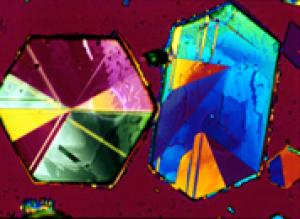Everyone breaks the rules from time to time - even crystals * Research revealing non-periodic crystals was recently published in the journal Science

"There are different kinds of rules regarding the behavior of crystals during trans-phenomena," says Mark D. Hollingsworth, associate professor of chemistry at the University of Kansas. "For a long time, scientists have assumed that a uniform standard is common to different types of materials. However, non-cyclic materials - those that lack a repeating regular structure - do not necessarily behave this way," says Hollingsworth. These non-periodic, rule-breaking crystals are the focus of the article by Hollingsworth and his writing partners which was published on January XNUMXth in the journal "Science". Based on the results of Hollingsworth's colleague, the French researcher Bertrand Tody, the two and their co-authors observed how these non-periodic crystals behave differently from "standard" periodic crystals. These changes could have implications not only for research in general, but also for technologies based on crystals, from computer monitors to hardware components, says Hollingsworth. He and his colleagues observed crystals that formed structures of the "host-guest" type, or as they are called professionally, "Inclusion Compounds". In the present case, Urea mares created canals around Nonadakan mares, obtaining a honeycomb-like structure. This structure adopts a spatial arrangement of a double helix - the structure of DNA. In periodic hybrid crystals, says the researcher, the host cells form the channels and the guest cells within create a regular and periodic structure. However, this is not the case for these non-periodic, rule-breaking crystals. "Sometimes the separate hosts and guests are well suited to each other, but sometimes they are not," says Hollingsworth.
"This behavior can have a major impact on a variety of traits. During the growth of the crystal, for example, crystals with a periodic and non-periodic hybrid system can behave in a completely different way." In non-periodic crystals, where the structural compatibility between the host and guest crystals is not perfect, the guest crystals protrude outside the boundaries of the crystals, thus creating a rough surface. Hence it is possible to tie new furrows to the ends of the crystal. Such crystals, including those described in the article, have the shape of elongated needles. The observations become interesting when the crystals move between one instance (phase) and another. "Bertrand and I have been discussing this issue for many years trying to understand what is really going on in this system," says Hollingsworth. "The goal in studying such systems is a deeper and better understanding of how the various instances are replaced by non-cyclic materials."
To find out what exactly happens in the show transitions, the researchers observed the crystals in a variable temperature range, above the show transition point, when the guest moles move at high speed within the channels created by the host moles, as well as at extremely low temperatures, where the moles are almost "frozen" in place. In order to examine the crystals, the researchers passed neutrons through the crystals and measured different types of reflections. One type of return, called "satellite return", is measured according to the interrelationships between the host-guest pairs. The researchers were very surprised by the observation that came to their eyes when the crystals were cooled to a temperature of -190 degrees Fahrenheit (about 124 degrees Celsius). The Levinian returns showed changes in the interrelationships between the different types of mares, but did not show any measurable changes in the structure of the mares themselves.
"In the past, we believed that these materials have a uniform transition-manifestation and that the usual laws regarding breaking symmetry also apply to them," says Hollingsworth. "I don't think that anyone could have anticipated what was happening in this transition-shows. Since these non-cyclic materials do not behave according to the same laws, Hollingsworth claims that the impact on the research is that it is the duty of the scientists to understand the laws by which these crystals behave in transitions. In addition to affecting the research, these differences can also affect the technology itself.
The crystals described in the article are also ferroelastic. This means - the separations inside the crystals return to their original position when external pressure is applied to the crystals. Researchers can do this with a small anvil while watching the displacement of broad complexes in the crystals and identifying these displacements under a microscope. Similar materials of the ferroelectric type are important for technology because the complexes within these materials can return to their original position with the help of transferring an electric field, thereby allowing or preventing polarized light to pass through them. These properties make these materials effective in electronic displays. "The question is whether these transitions, which we watched, will have extraordinary and effective properties," says the author. As research continues on aperiodic crystals, Hollingsworth said researchers are expected to discover this unusual behavior of phase transitions in other materials, other than the nonadecane-type crystals used in this study.
To the announcement of the University of Kansas on the Science Daily website

One response
The research sounds very interesting. But it is surprising to find out that there are scientists who use degrees Fahrenheit.